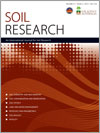SR13090Measurements of riverbed hydraulic conductivity in a semi-arid lowland river system (Murray–Darling Basin, Australia)
The hydraulic conductivity of riverbeds (Kr) is a key control on water exchange between rivers and alluvial aquifers, but is seldom measured. Kr was measured in four tributaries of the Murray-Darling Basin, where groundwater extraction from alluvial aquifers is extensive. While within site variability in Kr was large, the river reaches studied could be classified as having a low or high Kr, consistent with the two main types of riverbed texture present (clay or silty sand).




